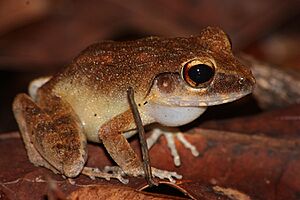Cornufer papuensis facts for kids
Quick facts for kids Cornufer papuensis |
|
|---|---|
 |
|
| C. papuensis calling on the forest floor on Normanby Is., Papua New Guinea | |
| Conservation status | |
| Scientific classification | |
| Synonyms | |
|
The Papua wrinkled ground frog, also known as Cornufer papuensis, is a type of frog. It belongs to the Ceratobatrachidae family. You can find this frog in northern New Guinea and on many nearby islands. These include places like the Bismarck Archipelago, D'Entrecasteaux Islands, and Trobriand Islands in Papua New Guinea. It also lives on the Maluku Islands, like Sula Islands and Seram Island, in Indonesia.
What Does It Look Like?
These frogs are not very big. Male frogs can grow to about 46 mm (1.8 in) long. Female frogs are a bit larger, reaching up to 64 mm (2.5 in). This measurement is called their snout–vent length, which means from their nose to the end of their body.
Their toes have a small amount of webbing at the bottom. The frog's back, called the dorsum, has many short skin folds. These folds make it look a bit wrinkled.
These frogs can have different color patterns on their backs:
- Some are just one solid color.
- Others have two stripes along their sides.
- Some have a single stripe down the middle of their back.
Frog Calls
Male Papua wrinkled ground frogs make loud calls. These calls are made of short bursts of sound, like pulses. Each sound burst lasts about 96 to 157 milliseconds. There is a short quiet time between each burst, lasting 130 to 306 milliseconds. They don't call very fast, making about four sound bursts per second.
Where Do They Live?
The Papua wrinkled ground frog is very common in many areas where it lives. It can be found in many different places. These include thick rain forests and areas where forests are regrowing. They also live in gardens and other places changed by humans.
These frogs prefer to live in lowlands, below 1,200 m (3,900 ft) in height. Males usually call at night. Sometimes, they start calling even before the sun sets. They call from the ground in the rain forest. They might sit out in the open or find a slightly hidden spot among fallen leaves. Sometimes, they even call from low bushes.
How Are They Doing?
This frog species is doing very well. It is found in many places and can adapt to different environments. There are no known big threats to this widespread frog. It also lives in many protected areas, which helps keep its populations safe.


